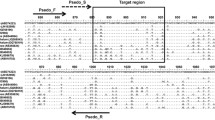Abstract
Two tapeworm specimens collected in northeast China in 2009 and 2011 were identified as Diphyllobothrium latum based on morphological criteria. Molecular methods were used to confirm their identity and analyze genetic variations compared with published data for this species. Species identity was confirmed by molecular characterization of the 18S rDNA partial sequence, complete sequences of internal transcribed spacers (ITSs) and 5.8S rDNA, and partial sequences of mitochondrial cytochrome c oxidase subunit 1 (cox1) and mitochondrial NADH dehydrogenase subunit 5 (nad5). PCR amplification and sequence analysis of 18S rDNA (1472 bp), ITS regions (1218 bp), cox1 (885 bp), and nad5 (1028 bp) revealed that these four sequences showed more than 99% identity to reference sequences for D. latum, confirming that this species is D. latum. To date, a total of 12 diphyllobothriosis cases have been documented in China. This study represents the first molecular characterization of D. latum in China, providing molecular evidence of human diphyllobothriosis in China.
Similar content being viewed by others
References
Baer J.G., Miranda C.H., Fernancdees R.W., Median T.J. 1967. Human diphyllobothriasis in Peru. Zeitschrift für Parasitenkunde, 28, 277–289.
Brabec J., Kuchta R., Scholz T. 2006. Paraphyly of the Pseudophyllidea (Platyhelminthes: Cestoda): circumscription of monophyletic clades based on phylogenetic analysis of ribosomal RNA. International Journal for Parasitology, 36, 1535–1541. DOI: 10.1016/j.ijpara.2006.08.003.
Chen B.J., Li L.S., Ling J.X., Lin Y.S., Li Y.R. 2005. A case of human diphyllobothriasis after eating Plecoglossus altivelis. Journal of Tropical Diseases and Parasitology, 3, 126.
Chen X.T. (Ed.). 1965. Medical Parasitology. People’s Health Publishing, Beijing, China.
Chou H.F., Yen C.M., Liang W.C., Jong Y.J. 2006. Diphyllobothriasis latum: the first child case report in Taiwan. Kaohsiung Journal of Medical Sciences, 22, 346–351. DOI: 10.1016/S1607-551X(09)70321-3.
Dick T. 2008. Diphyllobothriasis: the Diphyllobothrium latum human infection conundrum and reconciliation with a worldwide zoonosis. In: (Eds. K.D. Murrell and B. Fried) Food-borne Parasitic Zoonoses: fish and plant-borne parasites (world class parasites). Springer Publishing, London, UK, 151–184.
Dick T.A., Nelson P.A., Choudhury A. 2001. Diphyllobothriasis: update on human cases, foci, patterns and sources of human infections and future considerations. Southeast Asian Journal of Tropical Medicine Public Health, 32, 59–76.
Dupouy-Camet J., Peduzzi R. 2004. Current situation of human diphyllobothriasis in Europe. Euro Surveillance, 9, 31–35.
Fan S.Q., Wang G.Y., Sun M.F. 1995. A case of Diphyllobothrium latum infection in Heilongjiang. Chinese Journal of Parasitology and Parasite Diseases, 13, 240.
Faust E.C., Russell P.F. (Ed.). 1964. Craig and Faust’s Clinical Parasitology. Lea & Febiger, Philadelphia, USA, 977 pp.
Lee E.B., Song J.H., Park N.S., Kang B.K., Lee H.S., Han Y.J., Kim H., Shin E., Chai J. 2007. A case of Diphyllobothrium latum infection with a brief review of diphyllobothriasis in the Republic of Korea. Korean Journal of Parasitology, 45, 219–223. DOI: 10.3347/kjp.2007.45.3.219.
Lin C.S., Wu L.T. 1927. Report of a preliminary health survey of pinchiang (Chinese City of Harbin). National Medicine Journal of China, 13, 24–28.
Lou H.Y., Tsai P.C., Chang C.C., Lin Y.H., Liao C.W., Kao T.C., Lin H.C., Lee W.C., Fan C.K. 2007. A case of human diphyllobothriasis in northern Taiwan after eating raw fish fillets. Journal of Microbiology, Immunology Infection, 40, 452–456.
Nakao M., Abmed D., Yamasaki H., Ito A. 2007. Mitochondrial genomes of the human broad tapeworms Diphyllobothrium latum and Diphyllobothrium nihonkaiense (Cestoda: Diphyllobothriidae). Parasitology Research, 101, 233–236. DOI:10.1007/s00436-006-0433-3.
Osorio G., Daiber A., Donckaster R., Ubilla M., Con I., Anguita T., Pinto R. 1974. Severe megaloblastic anemia due to Diphyllobothrium latum. First case identified in Chile. Revista Medica de Chile 102, 700–703.
Park J.K., Kim K.H., Kang S., Jeon H.K., Kim J.H., Littlewood D.T.J., Eom K.S. 2007. Characterization of the mitochondrial genome of Diphyllobothrium latum (Cestoda: Pseudophyllidea) — implications for the phylogeny of eucestodes. Parasitology, 134, 749–759. DOI:10.1017/S003118200600206X.
Rohela M., Jamaiah I., Chan KW., Yusoff W.S. 2002. Diphyllobothriasis: the first case report from Malaysia. Southeast Asian Journal of Tropical Medicine Public Health, 33, 229–230.
Rohela M., Jamaiah I., Goh K.L, Nissapatorn V. 2006. A second case of diphyllobothriasis in Malaysia. Southeast Asian Journal of Tropical Medicine Public Health, 37, 896–898.
Santos F.L.N., De Faro L.B. 2005. The first confirmed case of Diphyllobothrium latum in Brazil. Memórias do Instituto Oswaldo Cruz, 100, 685–686. DOI: 10.1590/S0074-02762005000600013.
Scholz T., Garcia H.H., Kuchta R., Wicht B. 2009. Update on the Human Broad Tapeworm (Genus Diphyllobothrium), Including Clinical Relevance. Clinical Microbiology Reviews, 22, 146–160. DOI: 10.1128/CMR.00033-08.
Semenas L., Kreiter A., Urbanski J. 2001. New cases of human diphyllobothriasis in Patagonia, Argentina. Revista de Saúde Pública, 35, 214–216. DOI: 10.1590/S0034-89102001000200017.
Tamura K., Peterson D., Peterson N., Stecher G., Nei M., Kumar S. 2011. MEGA5: Molecular Evolutionary Genetics Analysis using Maximum Likelihood, Evolutionary Distance, and Maximum Parsimony Methods. Molecular Biology and Evolution, 28, 2731–2739. DOI: 10.1093/molbev/msr121.
Waloch M. 2005. Cestode infections in Poland in 2003. Przegląd Epidemiologiczny, 59, 331–335.
Wicht B., Yanagida T., Scholz T., Ito A., Jiménez J.A., Brabec J. 2010. Multiplex PCR for the differential diagnosis of human broad tapeworms (Cestoda: Diphyllobothrium) infecting humans. Journal of Clinical Microbiology, 48, 3111–3116. DOI: 10.1128/JCM.00445-10.
Yera H., Nicoulaud J., Dupouy-Camet J. 2008. Use of nuclear and mitochondrial DNA PCR and sequencing for molecular identification of Diphyllobothrium isolates potentially infective for humans. Parasite, 15, 402–407.
Zhang Y.R., Wu Z.Q., Liu X. 1996. A case of Diphyllobothrium latum infection. Chinese Journal of Parasitic Disease Control, 9, 211.
Author information
Authors and Affiliations
Corresponding authors
Rights and permissions
About this article
Cite this article
Guo, AJ., Liu, K., Gong, W. et al. Molecular identification of Diphyllobothrium latum and a brief review of diphyllobothriosis in China. Acta Parasit. 57, 293–296 (2012). https://doi.org/10.2478/s11686-012-0036-3
Accepted:
Published:
Issue Date:
DOI: https://doi.org/10.2478/s11686-012-0036-3




